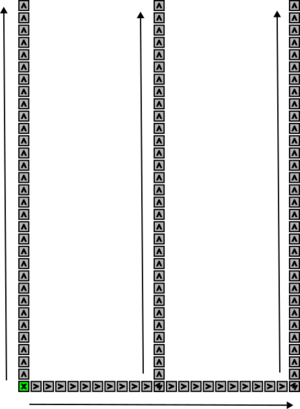Difference between revisions of "Pattern Self-Assembly"
m |
|||
| Line 1: | Line 1: | ||
[[Category:Self-assembly]] | [[Category:Self-assembly]] | ||
[[Category:Results in the aTAM]] | [[Category:Results in the aTAM]] | ||
| + | |||
| + | ==Abstract== | ||
| + | In the abstract Tile Assembly Model, self-assembling systems consisting of tiles of different colors can form structures on which | ||
| + | colored patterns are “painted.” We explore the complexity, in terms of | ||
| + | the unique tile types required, of assembling various patterns, proving | ||
| + | several upper and lower bounds. | ||
| + | |||
When designing a self-assembling system, the desired goal may be the creation of an assembly with a target shape. However, it may instead be an assembly that serves as surface onto which a desired pattern of cargo molecules are attached. In the domain of the [[Abstract_Tile_Assembly_Model_(aTAM)| aTAM]], this problem is typically represented as the problem of [[Weak_Self-Assembly | weakly self-assembling]] a pattern of colored tiles. | When designing a self-assembling system, the desired goal may be the creation of an assembly with a target shape. However, it may instead be an assembly that serves as surface onto which a desired pattern of cargo molecules are attached. In the domain of the [[Abstract_Tile_Assembly_Model_(aTAM)| aTAM]], this problem is typically represented as the problem of [[Weak_Self-Assembly | weakly self-assembling]] a pattern of colored tiles. | ||
| − | + | {| class="wikitable" | |
| + | |- | ||
| + | | [[File:Skeleton1.png|thumb|center|The skeleton. The green tile represents the seed]] | ||
| + | | [[File:SkeletonFilled.png|thumb|center|The square once the ribs of the skeleton have filled in (blue growing left, yellow growing right)]] | ||
| + | |} | ||
Revision as of 14:40, 3 March 2024
Abstract
In the abstract Tile Assembly Model, self-assembling systems consisting of tiles of different colors can form structures on which colored patterns are “painted.” We explore the complexity, in terms of the unique tile types required, of assembling various patterns, proving several upper and lower bounds.
When designing a self-assembling system, the desired goal may be the creation of an assembly with a target shape. However, it may instead be an assembly that serves as surface onto which a desired pattern of cargo molecules are attached. In the domain of the aTAM, this problem is typically represented as the problem of weakly self-assembling a pattern of colored tiles.
File:SkeletonFilled.png The square once the ribs of the skeleton have filled in (blue growing left, yellow growing right) |
A set of Python and Java programs that generate aTAM systems related to these constructions, as well as example systems, can be downloaded here:
SelfAssembledPatterns code (Note that the latest version can be found at the bottom of the list.)
